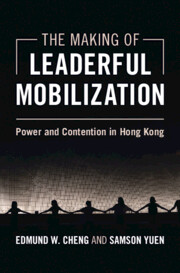84 results
Is it what you say or how you say it?
-
- Journal:
- Experimental Economics / Volume 27 / Issue 4 / September 2024
- Published online by Cambridge University Press:
- 14 March 2025, pp. 874-921
-
- Article
-
- You have access
- Open access
- HTML
- Export citation
The “China Threat” Theory and Okinawa
-
- Journal:
- Asia-Pacific Journal / Volume 22 / Issue 10 / October 2024
- Published online by Cambridge University Press:
- 14 March 2025, e1
-
- Article
-
- You have access
- Export citation
6 - The Barren Fig Tree (Lk 13:6–9)
-
- Book:
- Luke's Unique Parables
- Published online:
- 28 February 2025
- Print publication:
- 06 March 2025, pp 65-70
-
- Chapter
- Export citation
Implicit neural sensitivity for negatively valued social and non-social visual scenes in young adults exposed to childhood adversity
-
- Journal:
- Psychological Medicine / Volume 55 / 2025
- Published online by Cambridge University Press:
- 11 February 2025, e37
-
- Article
-
- You have access
- Open access
- HTML
- Export citation

The Making of Leaderful Mobilization
- Power and Contention in Hong Kong
-
- Published online:
- 30 January 2025
- Print publication:
- 06 February 2025
Perceived threat and demographic misperception
-
- Journal:
- Politics and Religion , First View
- Published online by Cambridge University Press:
- 24 January 2025, pp. 1-14
-
- Article
-
- You have access
- Open access
- HTML
- Export citation
7 - How Demagogues Do It
-
- Book:
- Brexitspeak
- Published online:
- 22 November 2024
- Print publication:
- 05 December 2024, pp 147-169
-
- Chapter
- Export citation
Developmental mechanisms linking deprivation and threat to psychopathology and school outcomes
-
- Journal:
- Development and Psychopathology , First View
- Published online by Cambridge University Press:
- 21 October 2024, pp. 1-12
-
- Article
-
- You have access
- HTML
- Export citation
Characterizing the role of unpredictability within different dimensions of early life adversity
-
- Journal:
- Development and Psychopathology , First View
- Published online by Cambridge University Press:
- 01 October 2024, pp. 1-15
-
- Article
-
- You have access
- Open access
- HTML
- Export citation
4 - Seeking the Self in the Extreme
- from Part I - The Link between Exclusion and Extremism
-
-
- Book:
- Exclusion and Extremism
- Published online:
- 16 May 2024
- Print publication:
- 23 May 2024, pp 74-96
-
- Chapter
- Export citation
8 - It’s the Group, Not Just the Individual
- from Part II - Drivers of the Exclusion–Extremism Link
-
-
- Book:
- Exclusion and Extremism
- Published online:
- 16 May 2024
- Print publication:
- 23 May 2024, pp 166-183
-
- Chapter
- Export citation
Do dimensions of childhood adversity differ in their direct associations with youth psychopathology? A meta-analysis
-
- Journal:
- Development and Psychopathology , First View
- Published online by Cambridge University Press:
- 08 April 2024, pp. 1-31
-
- Article
-
- You have access
- Open access
- HTML
- Export citation

Immigration, Security, and the Liberal State
- The Politics of Migration Regulation in Europe and the United States
-
- Published online:
- 09 February 2024
- Print publication:
- 18 January 2024
5 - Immigration and the Politics of Threat
-
- Book:
- Immigration, Security, and the Liberal State
- Published online:
- 09 February 2024
- Print publication:
- 18 January 2024, pp 236-261
-
- Chapter
- Export citation
1 - Introduction
-
- Book:
- Immigration, Security, and the Liberal State
- Published online:
- 09 February 2024
- Print publication:
- 18 January 2024, pp 1-29
-
- Chapter
- Export citation
8 - “Credible Threat” – School Safety Case Study
-
- Book:
- Understanding the Role of Equity
- Published online:
- 12 October 2023
- Print publication:
- 26 October 2023, pp 89-98
-
- Chapter
- Export citation
Less Human Than Human: Threat, Language, and Relative Dehumanization
-
- Journal:
- British Journal of Political Science / Volume 54 / Issue 3 / July 2024
- Published online by Cambridge University Press:
- 16 October 2023, pp. 612-628
-
- Article
-
- You have access
- Open access
- HTML
- Export citation
Does reward processing moderate or mediate the link between childhood adversity and psychopathology: A longitudinal study
-
- Journal:
- Development and Psychopathology / Volume 35 / Issue 5 / December 2023
- Published online by Cambridge University Press:
- 09 August 2023, pp. 2338-2351
-
- Article
-
- You have access
- Open access
- HTML
- Export citation
3 - Understanding Political and Intangible Elements in Modern Wars
-
-
- Book:
- Rethinking Warfare in the 21st Century
- Published online:
- 29 June 2023
- Print publication:
- 13 July 2023, pp 58-78
-
- Chapter
- Export citation
Dual Evolutionary Foundations of Political Ideology Predict Divergent Responses to COVID-19
-
- Journal:
- British Journal of Political Science / Volume 53 / Issue 3 / July 2023
- Published online by Cambridge University Press:
- 05 April 2023, pp. 861-877
-
- Article
-
- You have access
- Open access
- HTML
- Export citation


